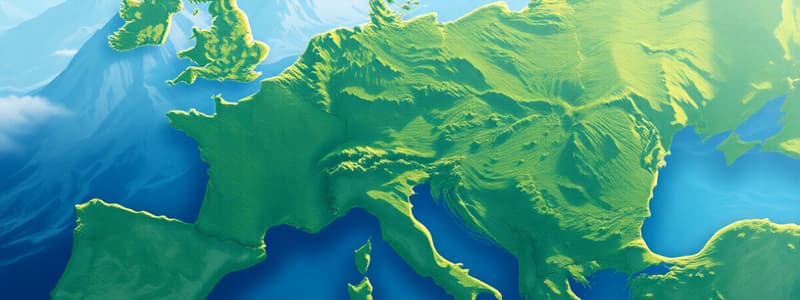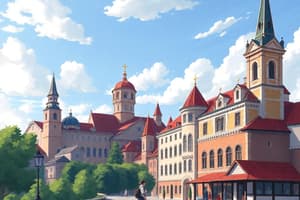Podcast
Questions and Answers
Which of the following best describes the strategic significance of Eastern Europe's geographic location?
Which of the following best describes the strategic significance of Eastern Europe's geographic location?
- Its landlocked location promotes a singular focus on internal development.
- Its isolation from major seas limits trade opportunities.
- Its primary importance is as a buffer zone with limited economic value.
- Its central position provides connectivity to Western Europe, Russia, and access to multiple seas. (correct)
How do the rivers of Eastern Europe impact its economic and social landscape?
How do the rivers of Eastern Europe impact its economic and social landscape?
- Rivers contribute little to the economy due to seasonal freezing and navigational challenges.
- Rivers mainly serve as borders, limiting cross-border interactions and trade.
- Rivers are primarily used for hydroelectric power, with minimal impact on transport.
- Rivers act as major transport routes, fostering trade and movement of people. (correct)
A business is looking to establish a distribution hub in Eastern Europe to serve multiple markets. Considering the region's geography, which factor would be most crucial in their decision-making process?
A business is looking to establish a distribution hub in Eastern Europe to serve multiple markets. Considering the region's geography, which factor would be most crucial in their decision-making process?
- The proximity to major transportation routes, including rivers and sea ports. (correct)
- The average annual rainfall in the region.
- The predominant agricultural output of the surrounding countries.
- The political stability of countries furthest from Western Europe.
Which factor has not significantly contributed to curbing population growth in Eastern Europe since the 1990s?
Which factor has not significantly contributed to curbing population growth in Eastern Europe since the 1990s?
Which of the following seas does NOT directly border Eastern Europe, based on the provided list of countries?
Which of the following seas does NOT directly border Eastern Europe, based on the provided list of countries?
If a company wanted to establish trade routes utilizing both sea and river transport in Eastern Europe, which of the following combinations of countries and seas would offer the most strategic options?
If a company wanted to establish trade routes utilizing both sea and river transport in Eastern Europe, which of the following combinations of countries and seas would offer the most strategic options?
Eastern Europe's economic development is characterized by:
Eastern Europe's economic development is characterized by:
Which of the following describes a significant challenge currently faced by many Eastern European states?
Which of the following describes a significant challenge currently faced by many Eastern European states?
What represents a defining characteristic of Eastern Europe's urbanization patterns?
What represents a defining characteristic of Eastern Europe's urbanization patterns?
What reflects a geopolitical shift affecting Eastern Europe?
What reflects a geopolitical shift affecting Eastern Europe?
How does the climate of Eastern Europe transition from west to east?
How does the climate of Eastern Europe transition from west to east?
The Danube River is a major waterway in Eastern Europe. Which of the following statements accurately describes its significance?
The Danube River is a major waterway in Eastern Europe. Which of the following statements accurately describes its significance?
Which of the following best describes the relationship between the plains and mountains in Eastern Europe?
Which of the following best describes the relationship between the plains and mountains in Eastern Europe?
If a country in Eastern Europe is located in the southeast of the subregion, which climatic influence is most likely to affect it?
If a country in Eastern Europe is located in the southeast of the subregion, which climatic influence is most likely to affect it?
Which of the following statements best describes the population distribution in Eastern Europe?
Which of the following statements best describes the population distribution in Eastern Europe?
A new bridge is planned to span a river in Eastern Europe to improve trade. Considering the details of the text, which river would offer the greatest potential for connecting multiple countries within the subregion?
A new bridge is planned to span a river in Eastern Europe to improve trade. Considering the details of the text, which river would offer the greatest potential for connecting multiple countries within the subregion?
A country straddling both the German-Polish plain and the Carpathian Mountains is MOST likely to experience which combination of geographical features?
A country straddling both the German-Polish plain and the Carpathian Mountains is MOST likely to experience which combination of geographical features?
If an Eastern European nation aims to boost its agricultural output, which of the following areas would be MOST suitable for large-scale farming?
If an Eastern European nation aims to boost its agricultural output, which of the following areas would be MOST suitable for large-scale farming?
Flashcards
Eastern Europe countries
Eastern Europe countries
Includes Latvia, Lithuania, Belarus, Ukraine, Czech Republic, Slovakia, Hungary, Romania, Bulgaria, Croatia, Slovenia, Serbia, Bosnia and Herzegovina, Montenegro, and Kosovo.
Eastern Europe borders
Eastern Europe borders
West and Russia.
Seas bordering Eastern Europe
Seas bordering Eastern Europe
Baltic, Black, and Mediterranean Seas.
Rivers Importance in Eastern Europe
Rivers Importance in Eastern Europe
Facilitate transportation of goods and people.
Signup and view all the flashcards
Eastern Europe's Geographic Significance
Eastern Europe's Geographic Significance
A region linked to other European areas, Russia, North Africa, and Southwest Asia.
Signup and view all the flashcards
Eastern Europe Physical Conditions
Eastern Europe Physical Conditions
Combination of mountains and plains, including the German-Polish Plain and the Carpathian Mountains.
Signup and view all the flashcards
Bohemian Range
Bohemian Range
Mountain range that separates plains; part of the Carpathian system.
Signup and view all the flashcards
Carpathian Mountains
Carpathian Mountains
Mountain range that continues into the Pannonian Range and the Wallachia plain.
Signup and view all the flashcards
Eastern Europe Climate
Eastern Europe Climate
Intermediate between Western and Continental; Mediterranean on coasts, Continental further east.
Signup and view all the flashcards
Continental Climate
Continental Climate
Harsh winters, with significant temperature variations.
Signup and view all the flashcards
Danube River
Danube River
Largest river, flows from Germany to the Black Sea and crosses 8 countries in the subregion.
Signup and view all the flashcards
Danube's Importance
Danube's Importance
Connects countries in the subregion, navigable.
Signup and view all the flashcards
Eastern Europe Population
Eastern Europe Population
Approximately 190 million.
Signup and view all the flashcards
Eastern European Mountains
Eastern European Mountains
Mountain ranges in Eastern Europe including the Karpathians, Rhodope, and Albanian Alps.
Signup and view all the flashcards
Urbanization levels in Eastern Europe
Urbanization levels in Eastern Europe
The Czech Republic has high urbanization, while Bosnia and Herzegovina has low urbanization.
Signup and view all the flashcards
Factors slowing population growth in Eastern Europe
Factors slowing population growth in Eastern Europe
Slower migration, mainly to Western Europe, and declining birth rates.
Signup and view all the flashcards
Eastern Europe's economic status
Eastern Europe's economic status
Lowest per capita income with weak industry and agriculture.
Signup and view all the flashcards
Social issues in Eastern Europe
Social issues in Eastern Europe
Social problems related to their communist past, affecting democratic development.
Signup and view all the flashcardsStudy Notes
- Eastern Europe includes Latvia, Lithuania, Belarus, Ukraine, the Czech Republic, Slovakia, Hungary, Romania, Bulgaria, Serbia, Bosnia and Herzegovina, Montenegro, North Macedonia, Albania, and Kosovo.
- Among these, the countries of the Balkan Peninsula are Croatia, Slovenia, Serbia, Albania, North Macedonia, Bosnia and Herzegovina, and Kosovo.
- Bulgaria and Romania are also known as countries of Southeastern Europe.
Geographical Position
- Eastern Europe extends from the Western European sub-region to the Russian region.
- To the north, it is bordered by the Baltic Sea, while to the southwest, it is bordered by the Mediterranean Sea.
- Eastern Europe has a fairly favorable geographical position because it can connect with all European sub-regions, as well as the regions of Russia, North Africa, and Southwest Asia.
- The exit of the sub-region to some seas (Baltic, Black Sea, Mediterranean) as well as river valleys in the interior creates connecting routes and suitable areas for the transport of goods and people.
Physical Conditions
- Eastern Europe is an area with quite diverse physical conditions.
- The terrain combines mountains, hills, and plains.
- To the north extends the German-Polish plain, which crosses the North European Plain.
- In the central and southern parts, there are mountainous and hilly areas, separated by small fertile plains.
- West of Transylvania is a continuation of the Carpathian Mountains.
- The plain of Wallachia extends between them, crossed by the Danube River.
- To the north of these plains are the mountains of Central Balkans, while to the southwest are the Dinaric Alps.
- As for the climate, the Eastern European sub-region is an intermediate zone between the marine climate of Western Europe and the continental climate in the east.
- The Mediterranean climate is found in the West to the interior of the Balkans.
- In the eastern part, the continental climate becomes more pronounced in eastern Poland.
- The southeastern territories of these countries, with a Mediterranean climate, are affected by air masses coming from the Black Sea.
- The sub-region has a dense network of rivers, the largest of which is the Danube.
- Danube rises in southern Germany and flows into the Black Sea.
- It is a navigable river and along its course passes through 8 countries of the sub-region (Romania, Bulgaria, Serbia, Croatia, Hungary, Slovakia, Moldova and Ukraine) and two outside of it (Austria and Germany).
- The river is an important transport route that connects the countries of the sub-region.
- There are also a series of other rivers that flow into the Baltic Sea, the Black Sea, and the Mediterranean.
- Eastern Europe also stands out for the diversity of its soils and living organisms.
Population of Eastern Europe
- The Eastern European sub-region has approximately 190 million inhabitants, with an average density of around 16 inhabitants per square kilometer.
- The most densely populated areas are northeastern Czechia, southern Poland, the urban areas of Ukraine, and the area around Budapest, while the mountainous areas have the lowest density.
Studying That Suits You
Use AI to generate personalized quizzes and flashcards to suit your learning preferences.





